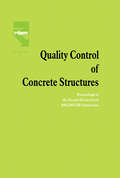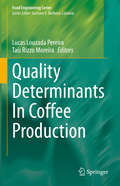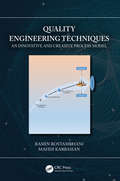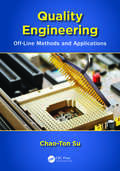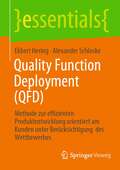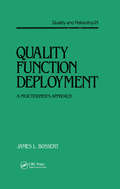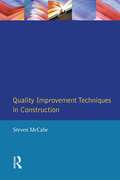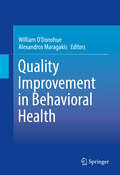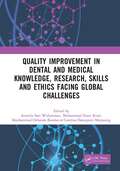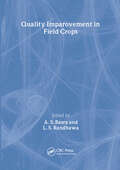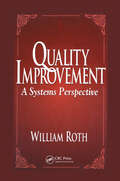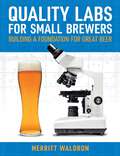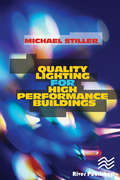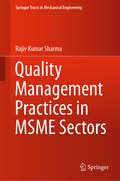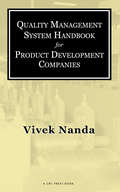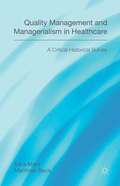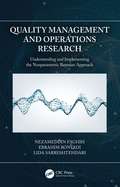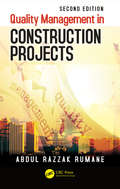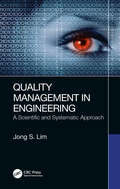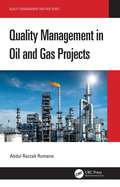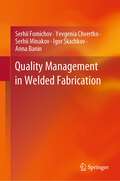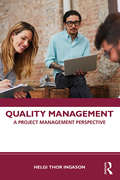- Table View
- List View
Quality Control of Concrete Structures: Proceedings of the Second International RILEM/CEB Symposium
by L. Taerwe H. LambotteThis book details the latest information on the applied methods and techniques being used for quality control of concrete construction worldwide. The book forms the proceedings of the Second International Symposium on Quality Control on Concrete Structures, held in Belgium, June 1991.
Quality Determinants In Coffee Production (Food Engineering Series)
by Lucas Louzada Pereira Taís Rizzo MoreiraQuality Determinants In Coffee Production presents a comprehensive overview of the main determinants of coffee quality during processing. Authored by members of the Laboratory for Analysis and Research in Coffee at the Federal Institute of Espírito Santo, the chapters in this text explain how coffee quality can be affected through each step of the main processing methods. The first section explores the history of coffee processing, covering how the processes and techniques of sensorial analysis have developed. The second section covers the evolution of these techniques and how various complexities can affect their use, plus the statistical tools that are used to increase test accuracy. Another section focuses on the relationship between fruit microbiology and coffee quality, promoting an understanding of how yeasts, fungi and bacteria effect the quality of coffee during processing. Another section is dedicated to the biotechnological processes used in coffee production, including the applicability of induced and spontaneous routes from the manipulation of raw material, the relationship between wet processing and spontaneous fermentation and the construction of sensorial routes. A final section explores volatile coffee compounds and gas chromatography techniques, including chemical and sensory maps. The majority of the reference works published on coffee processing have a pragmatic approach covering production, harvesting, post-harvesting and marketing. This work goes beyond these subjects, covering the factors that impact quality and how they lead to either qualitative reduction or gains during processing. New technological and scientific indicators for the modification and the creation of sensory routes are extensively covered, as are the international protocols used in the sensorial analysis of coffee. With its broad approach, this text presents a multidisciplinary perspective connecting areas such as statistics, biochemistry, analytical chemistry and microbiology to the results of sensory analysis using different technologies and processes. A direct relationship between these factors is established in order to help researchers understand their combined effect on coffee quality during processing.
Quality Engineering Handbook (Quality and Reliability)
by Thomas Pyzdek Paul A. KellerWritten by one of the foremost authorities on the subject, the Second Edition is completely revised to reflect the latest changes to the ASQ Body of Knowledge for the Certified Quality Engineer (CQE). This handbook covers every essential topic required by the quality engineer for day-to-day practices in planning, testing, finance, and management an
Quality Engineering Techniques: An Innovative and Creative Process Model
by Ramin Rostamkhani Mahdi KarbasianIn today’s industrial and complex world, the progress of change is incredible. The amount of information which needs to be analyzed is very large and time has become more and more limited. Industries and firms of all sizes desire to increase productivity and sustainability to keep their competitive edge in the marketplace. One of the best tools for achieving this is the application of Quality Engineering Techniques (QET). This book will introduce the integrated model and the numerical applications for implementing it.
Quality Engineering: Off-Line Methods and Applications
by Chao-Ton SuAs quality becomes an increasingly essential factor for achieving business success, building quality improvement into all stages-product planning, product design, and process design-instead of just manufacturing has also become essential. Quality Engineering: Off-Line Methods and Applications explores how to use quality engineering methods and othe
Quality Function Deployment: Methode zur effizienten Produktentwicklung orientiert am Kunden unter Berücksichtigung des Wettbewerbes (essentials)
by Ekbert Hering Alexander SchloskeDie Methode „Quality Function Deployment“ (QFD) ist eine Methode, die kompromisslos am Nutzen der Kunden orientiert ist. Sie zeigt zum einen die Stärken und Schwächen im Wettbewerbsumfeld und zum anderen den Stand der Technik bzw. den Zustand der Realisierung der Kundenanforderungen. Die Ergebnisse werden grafisch und damit übersichtlich in einem „Qualitätshaus“ zusammengefasst. Auf diese Weise können gezielt Wettbewerbsvorteile im Markt und in der Technik erzielt werden. Diese Methode ist universell einsetzbar. Dies zeigen exemplarisch Beispiele aus der Technik, der Dienstleistungsbranche (z. B. Krankenhäuser) oder Bildungseinrichtungen (z. B. Schulen und Hochschulen).
Quality Function Deployment: The Practitioner's Approach
by James L. BossertQuality Function Deployment is an information system producing structured data for quality managers and practitioners. This is a practical guide to implementing such a system for readers assumed to be familiar with it. Annotation copyright Book News, Inc. Portland, Or.
Quality Improvement Techniques in Construction: Principles and Methods (Chartered Institute of Building)
by Steven MccabeQuality management has received much attention in recent years, not least in the construction industry. This book provides a description of the techniques of quality management and how they are implemented, regardless of the context. The author applies the techniques to the construction industry and brings in some practical experience from contractors in the construction industry.
Quality Improvement in Behavioral Health
by William O'Donohue Alexandros MaragakisThis innovative volume presents a cogent case for quality improvement(QI) in behavioral healthcare as ethical practice, solid science, and goodbusiness. Divided between foundational concepts, key QI tools and methods, andemerging applications, it offers guidelines for raising care standards whileaddressing ongoing issues of treatment validity, staffing and training, costsand funding, and integration with medical systems. Expert contributors reviewthe implications and potential of QI in diverse areas such as treatment ofentrenched mental disorders, in correctional facilities, and within theprofessional context of the American Psychological Association. The insights,examples, and strategies featured will increase in value as behavioral healthbecomes more prominent in integrated care and vital to large-scale health goals. Included in the coverage: Behavioral health conditions: direct treatment costs and indirect social costs. Quality improvement and clinical psychological science. · Processmapping to improve quality in behavioral health service delivery. · Checklists for quality improvement and evaluation in behavioralhealth. · Creating a quality improvement system for an integrated careprogram: the why, what, and how to measure. · Feedback Informed Treatment (FIT): improving the outcome ofpsychotherapy one person at a time. Quality Improvement i n Behavioral Healthcare gives healthpsychologists, public health professionals, and health administrators areal-world framework for maintaining quality services in a rapidly evolvinghealth landscape.
Quality Improvement in Dental and Medical Knowledge, Research, Skills and Ethics Facing Global Challenges: Proceedings of the International Conference on Technology of Dental and Medical Sciences (ICTDMS 2022), Jakarta, Indonesia, 8-10 December 2022
by Armelia Sari Widyarman Muhammad Ihsan Rizal Moehammad Orliando Roeslan Carolina Damayanti MarpaungThe proceeding of FORIL XIII 2022 Scientific Forum Usakti conjunction with International Conference on Technology of Dental and Medical Sciences (ICTDMS) includes selected full papers that have been peer-reviewed and satisfy the conference's criteria. All studies on health, ethics, and social issues in the field of dentistry and medicine have been presented at the conference alongside clinical and technical presentations. The twelve primary themes that make up its framework include the following: behavioral epidemiologic, and health services, conservative dentistry, dental materials, dento-maxillofacial radiology, medical sciences and technology, oral and maxillofacial surgery, oral biology, oral medicine and pathology, orthodontics, pediatrics dentistry, periodontology, and prosthodontics. This proceeding is likely to be beneficial in keeping dental and medical professionals apprised of the most recent scientific developments.
Quality Improvement in Field Crops
by Lakhwinder S RandhawaLearn to identify, modify, and manipulate the genes controlling key quality traits in field crops!This informative book provides state-of-the-art information on improving nutritional quality as well as yield volume in field crops such as wheat, maize, rice, barley, oats, lentils, pigeon peas, soybeans, cool season legumes, and crops whose seeds are used to make oils. With contributions from leading authorities in the field, this book will bring you up to date on the uses of agronomic management, conventional plant breeding, and modern biotechnologies in improving the quality of important food, feed, and fiber products.Quality Improvement in Field Crops examines: factors that impact the end-use quality of wheat and ways to improve wheat’s quality for milling and baking agronomic practices that impact the quality of maize ways to improve the nutritional value of rice and legumes techniques for using molecular markers to improve the quality of lentil crops breeding methods that can improve the quality of the oils derived from oilseed crops protein quality/sulfur metabolism in soybeans and much more!This book is dedicated to the World Food Laureate (the equivalent of the Nobel Prize for food scientists), Dr. G. S. Khush--the father of the Green Revolution in rice farming--in recognition of his tremendous contributions to global food and nutritional security for the world?s population.
Quality Improvement: A Systems Perspective
by William RothQuality improvement: it's an attractive concept on paper. So why do the vast majority of quality improvement efforts fail?William Roth knows from experience: as a Ph.D in systems theory, an ex-corporate manager, a professor-and the designer (with the AQP) of a national program to deliver training for quality credentials in the systems approach. His belief: enduring quality improvement is an "all or nothing" situation-requiring a systemic approach, with all the key components and integrations in place and fully integrated right from the start. Quality Improvement: A Systems Perspective explains the sometimes surprising historic roots of the quality improvement movement, and outlines the systems theory on which successful models must be built. Readers then gain access to the hands-on, nuts-and-bolts, how-to-get-it-done details of the five critical phases. Three case studies (two in industry, one in health care) support this traditional but currently shunned model.Along with his unique unified view of quality improvement, Roth explains why it is shunned, and why alternative approaches usually do not produce the desired results. Key obstacles to success are directly identified-top-level management, local union leaders, management education. The ultimate culprit, though, is culture-to which Roth suggests how to move organizations in the right direction, from a systems perspective.With one of the most comprehensive overviews of quality management essentials in one volume, Quality Improvement: A Systems Perspective balances theory and modeling with the details of real-life implementation and success.
Quality Labs for Small Brewers: Building a Foundation for Great Beer
by Merritt WaldronQuality assurance and quality control (QA/QC) is both a system and a state of mind. In Quality Labs for Small Brewers, author Merritt Waldron walks you step-by-step through the process of establishing and writing a quality program for your brewery. Your quality policy should align with your company values and inculcate a quality-first culture throughout your brewery. Building an effective quality program will empower staff to directly influence the consistent production of safe, quality beer from grain to glass.A good quality program has many moving parts but it is underpinned by good manufacturing practice (GMP) and food safety requirements. GMP covers every aspect of a brewery's operation, not just how personnel comport themselves, but how goods in are handled and stored, how beer is held in the warehouse, and how equipment, plant, and the grounds are maintained. Learn how to set standards and critical control points, and how to effectively monitor your process so that any deviation is quickly addressed.Discover how policies, procedures, and specifications can help ensure quality throughout every process. Involve your staff in establishing standard operating procedures, corrective actions, and improvements. Learn how to effectively delegate responsibility and also ensure that management is armed with the information they need to ultimately make what may be some tough decisions. If the worst happens, understand that being able to make a tough call and having a robust recall procedure in place means you can move quickly to rectify matters, which helps your brewery retain the confidence of your customers and distributors.Brewers will see results through the application of GMP and food safety prerequisite programs. Your quality manual laying out standard operating procedures, product specifications, and corrective action plans will give your staff the confidence to implement your quality program. With these programs in place, the author then takes you through each area of your brewery operation and breaks down how key parameters are measured and analyzed at critical control points. Sampling plans are outlined for monitoring density, temperature, pH, yeast viability and growth, alcohol, carbonation, dissolved oxygen, titratable acidity, fill height, and packaging integrity. Explore setting up an effective sensory panel, even a small one, that will help ensure each beer remains true-to-brand. Waldron outlines building your brewery laboratory and looks at how to implement an in-house microbiology program. Throughout this, the focus is on scaling your efforts to the size of your operation and always being ready to expand your quality program as your brewery grows. The author makes it clear that no brewery is too small to implement QA/QC and discusses pragmatic solutions to building out your capabilities.Beyond taking meaningful, accurate measurements, the author also explores how to analyze data. Learn some basics of statistics and data organization and how to apply these techniques to continuously monitor processes and spot when corrective action is needed. These routines will help pinpoint any risks or areas of improvement and ensure that only quality beer reaches the customer, time after time.
Quality Lighting for High Performance Buildings
by Michael StillerThis book provides an overview of the basic concepts of quality, indoor lighting, and explains concepts like visual comfort, visual interest, and integrated design as they relate to the practice of lighting design. Energy-efficient lighting technologies, including LED lighting and digital control systems, and design strategies that increase visual comfort and productivity are discussed in plain language, and examined in a straightforward way to give the reader, whether an architect, interior designer, engineer, building trades professional, or student a broad understanding of the art and science of energy-efficient quality lighting.
Quality Management Practices in MSME Sectors (Springer Tracts in Mechanical Engineering)
by Rajiv Kumar SharmaThe book explains the importance of and investigates the quality management aspects in micro, small and medium enterprises (MSME) sectors. It emphasizes on the need of quality management practice and explores the applicability of various quality tools in MSMEs and stages in company where quality management practices are applied. Various topics covered in this book include control charts, Pareto charts, customer relationship management, failure mode effect analysis, QMS implementation stages, competitiveness, and benefits of QM practices. This book will be useful for the researchers and industry professionals from the areas of mechanical engineering, industrial engineering, and manufacturing.
Quality Management System Handbook for Product Development Companies
by Vivek NandaQuality Management System Handbook for Product Development Companies describes a systematic approach for quality management and continuous improvement via a formal management system.� The approach centers on a high-level process for defining a QMS � from essential prerequisites to improvement mechanisms. The book outlines the five major QMS
Quality Management and Managerialism in Healthcare
by Sara Melo Matthias BeckQuality Management and Managerialism in Healthcare creates a comprehensive and systematic international survey of various perspectives on healthcare quality management together with some of their most pertinent critiques. It reviews the factors which have underpinned the managerialist trajectory of healthcare management over the past decades.
Quality Management and Operations Research: Understanding and Implementing the Nonparametric Bayesian Approach
by Nezameddin Faghih Ebrahim Bonyadi Lida SarreshtehdariOffering a step-by-step approach for applying the Nonparametric Method with the Bayesian Approach to model complex relationships occurring in Reliability Engineering, Quality Management, and Operations Research, it also discusses survival and censored data, accelerated lifetime tests (issues in reliability data analysis), and R codes. This book uses the Nonparametric Bayesian approach in the fields of quality management and operations research. It presents a step-by-step approach for understanding and implementing these models, as well as includes R codes which can be used in any dataset. The book helps the readers to use statistical models in studying complex concepts and applying them to Operations Research, Industrial Engineering, Manufacturing Engineering, Computer Science, Quality and Reliability, Maintenance Planning and Operations Management. This book helps researchers, analysts, investigators, designers, producers, industrialists, entrepreneurs, and financial market decision makers, with finding the lifetime model of products, and for crucial decision-making in other markets.
Quality Management for Organizations Using Lean Six Sigma Techniques
by Erick JonesThe next step in the evolution of the organizational quality field, Lean Six Sigma (LSS) has come of age. However, many challenges to using LSS in lieu of, in conjunction with, or integrated with other quality initiatives remain. An update on the current focus of quality management, Quality Management for Organizations Using Lean Six Sigma Techniqu
Quality Management in Construction Projects (Systems Innovation Book Series)
by Abdul Razzak RumaneThe first edition published in 2010. The response was encouraging and many people appreciated a book that was dedicated to quality management in construction projects. <P><P>Since it published, ISO 9000: 2008 has been revised and ISO 9000: 2015 has published. The new edition will focus on risk-based thinking which must be considered from the beginning and throughout the project life cycle. <P><P>There are quality-related topics such as Customer Relationship, Supplier Management, Risk Management, Quality Audits, Tools for Construction Projects, and Quality Management that were not covered in the first edition. Furthermore, some figures and tables needed to be updated to make the book more comprehensive.
Quality Management in Engineering: A Scientific and Systematic Approach
by Jong S. LimThis book introduces fundamental, advanced, and future-oriented scientific quality management methods for the engineering and manufacturing industries. It presents new knowledge and experiences in the manufacturing industry with real world case studies. It introduces Quality 4.0 with Industry 4.0, including quality engineering tools for software quality and offers lean quality management methods for lean manufacturing. It also bridges the gap between quality management and quality engineering, and offers a scientific methodology for problem solving and prevention. The methods, techniques, templates, and processes introduced in this book can be utilized in various areas in industry, from product engineering to manufacturing and shop floor management. This book will be of interest to manufacturing industry leaders and managers, who do not require in-depth engineering knowledge. It will also be helpful to engineers in design and suppliers in management and manufacturing, all who have daily concerns with project and quality management. Students in business and engineering programs may also find this book useful as they prepare for careers in the engineering and manufacturing industries. Presents new knowledge and experiences in the manufacturing industry with real world case studies Introduces quality engineering methods for software development Introduces Quality 4.0 with Industry 4.0 Offers lean quality management methods for lean manufacturing Bridges the gap between quality management methods and quality engineering Provides scientific methodology for product planning, problem solving and prevention management Includes forms, templates, and tools that can be used conveniently in the field
Quality Management in Oil and Gas Projects (Quality Management and Risk Series)
by Abdul Razzak RumaneThis book provides the tools and techniques, management principles, procedures, concepts, and methods to ensure the successful completion of an oil and gas project while also ensuring the proper design, procurement, and construction for making the project most qualitative, competitive, and economical for safer operational optimized performance. It discusses quality during design, FEED, detailed engineering, selection of project teams, procurement procedure of EPC contract, managing quality during mobilization, procurement, execution, planning, scheduling, monitoring, control, quality, and testing to achieve the desired results for an oil and gas project. This book provides all the related information to professional practitioners, designers, consultants, contractors, quality managers, project managers, construction managers, and academics/instructors involved in oil and gas projects and related industries. Features Provides information on the various quality tools used to manage construction projects from inception to handover Discusses the life cycle phases, developed on systems engineering approach, and how it is divided into manageable activity/element/components segments to manage and control the project Includes a wide range of tools, techniques, principles, and procedures used to address quality management Covers quality management systems and development of quality management systems manuals Discusses quality and risk management, and health, safety, and environmental management during the design and construction process
Quality Management in Reverse Logistics
by Yiannis NikolaidisQuality Management in Reverse Logistics intends to develop, collect, examine and evaluate a number of quality management (QM) tools and techniques, which can be applied in practice in order to understand, review and improve any closed-loop supply chain process. In other words, the book aims to examine the existing relationship between various well-developed and thoroughly studied quality issues, such as QM, quality assurance, standardization of processes and statistical quality control and the emerging research area of reverse logistics. Quality Management in Reverse Logistics contains modeling and quantitative methods that could be used by practitioners and academics in the reverse logistics industry, as well as a thorough description of QM tools and techniques. The book leads the potential reader to broaden their scope of thinking and acting in the new, promising area of reverse logistics, where QM can be applied.
Quality Management in Welded Fabrication
by Serhii Fomichov Yevgenia Chvertko Anna Banin Serhii Minakov Igor SkachkovThis book focuses on topics in the field of welding science, technologies, and equipment, with a particular emphasis on quality management. The textbook consists of four modules covering quality management basics, measurement, imperfections, and non-destructive testing. The material is presented in an illustrated and uncomplicated manner. The textbook is based on the experience of professors of the National Technical University of Ukraine and the Approved Training Body for International Welding Engineers and Technologists of the International Institute of Welding, making it an ideal resource for graduate and postgraduate students, university professors, and welding specialists.
Quality Management: A Project Management Perspective
by Helgi Thor IngasonThe implementation of quality management can be seen as a sequence of projects and evolves as a result of how projects are planned, executed and closed. This book explores quality management from a project management perspective, based on the author’s long experience of teaching and practicing, including the implementation and operation of quality management systems within various types of organisations. The author explores the origins of quality management as a discipline, it’s appearance in the present form and how quality management can be implemented and applied in all kinds of organisations to achieve stability and better results. The basic principles of quality management and the ISO9001 quality management standard are discussed and explained from a broad perspective, with illustrative examples from different types of organisations. Quality Management offers a global, accessible guide for undergraduate and postgraduate university students. Written clearly and with illustrative examples, it will also appeal to all those interested in project management and quality management and wishing to expand their knowledge base.
